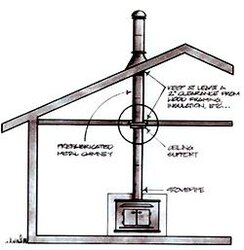I'd really prefer installing this stovepipe myself. Seems like a fun project and I'd learn a bunch too. So in my research I've uncovered a few things that set me at ease that I wouldn't be breaking any SC building codes by doing it my self. And that my insurance company doesn't have any rules around that either (just got off the phone with my local State Farm office). While reading through SC building code I finally came to the section that applies to installing a stovepipe. Here it is for the convenience of any curious folks here.
"SECTION 5-25-700. Stovepipe construction.
No stovepipe shall pass through any roof window or weatherboarding and no stovepipe in any building with wood or combustible floors, ceilings or partitions shall enter any flue unless such pipe shall be at least twelve inches from such floors, ceilings or partitions, or unless it is properly protected by a metal shield, in which case the distance shall not be less than six inches. When stovepipes pass through wooden partitions of any kind or other woodwork, they shall be guarded by either a double collar of metal, with at least three inches air space and holes for ventilation, or by a soapstone or burnt-clay ring not less than one inch in thickness extending through the partition or other woodwork.
HISTORY: 1962 Code Section 47-1237; 1952 Code Section 47-1237; 1942 Code Section 7507; 1932 Code Section 7507; Civ. C. '22 Section 4622; 1917 (30) 77. "
From this webpage: http://www.scstatehouse.gov/code/t05c025.php
I'm posting this because early on in my research I seemed to see a lot of legality comments like, "Make sure your state/city doesn't require your install to be certified afterward." "Make sure your insurance company doesn't drop your policy because they found out you didn't use a certified professional." Things like that. I don't want to be blissfully unaware. But so far I don't see that I'd run afoul of any laws or insurance agreements as long as I do my research properly and do the installation to code myself. This will be my first rodeo and I know pros know more than me. If anyone reads this and knows I'm asking for trouble installing my wood stove and stove pipe myself please speak up or PM me. Thanks!
"SECTION 5-25-700. Stovepipe construction.
No stovepipe shall pass through any roof window or weatherboarding and no stovepipe in any building with wood or combustible floors, ceilings or partitions shall enter any flue unless such pipe shall be at least twelve inches from such floors, ceilings or partitions, or unless it is properly protected by a metal shield, in which case the distance shall not be less than six inches. When stovepipes pass through wooden partitions of any kind or other woodwork, they shall be guarded by either a double collar of metal, with at least three inches air space and holes for ventilation, or by a soapstone or burnt-clay ring not less than one inch in thickness extending through the partition or other woodwork.
HISTORY: 1962 Code Section 47-1237; 1952 Code Section 47-1237; 1942 Code Section 7507; 1932 Code Section 7507; Civ. C. '22 Section 4622; 1917 (30) 77. "
From this webpage: http://www.scstatehouse.gov/code/t05c025.php
I'm posting this because early on in my research I seemed to see a lot of legality comments like, "Make sure your state/city doesn't require your install to be certified afterward." "Make sure your insurance company doesn't drop your policy because they found out you didn't use a certified professional." Things like that. I don't want to be blissfully unaware. But so far I don't see that I'd run afoul of any laws or insurance agreements as long as I do my research properly and do the installation to code myself. This will be my first rodeo and I know pros know more than me. If anyone reads this and knows I'm asking for trouble installing my wood stove and stove pipe myself please speak up or PM me. Thanks!




